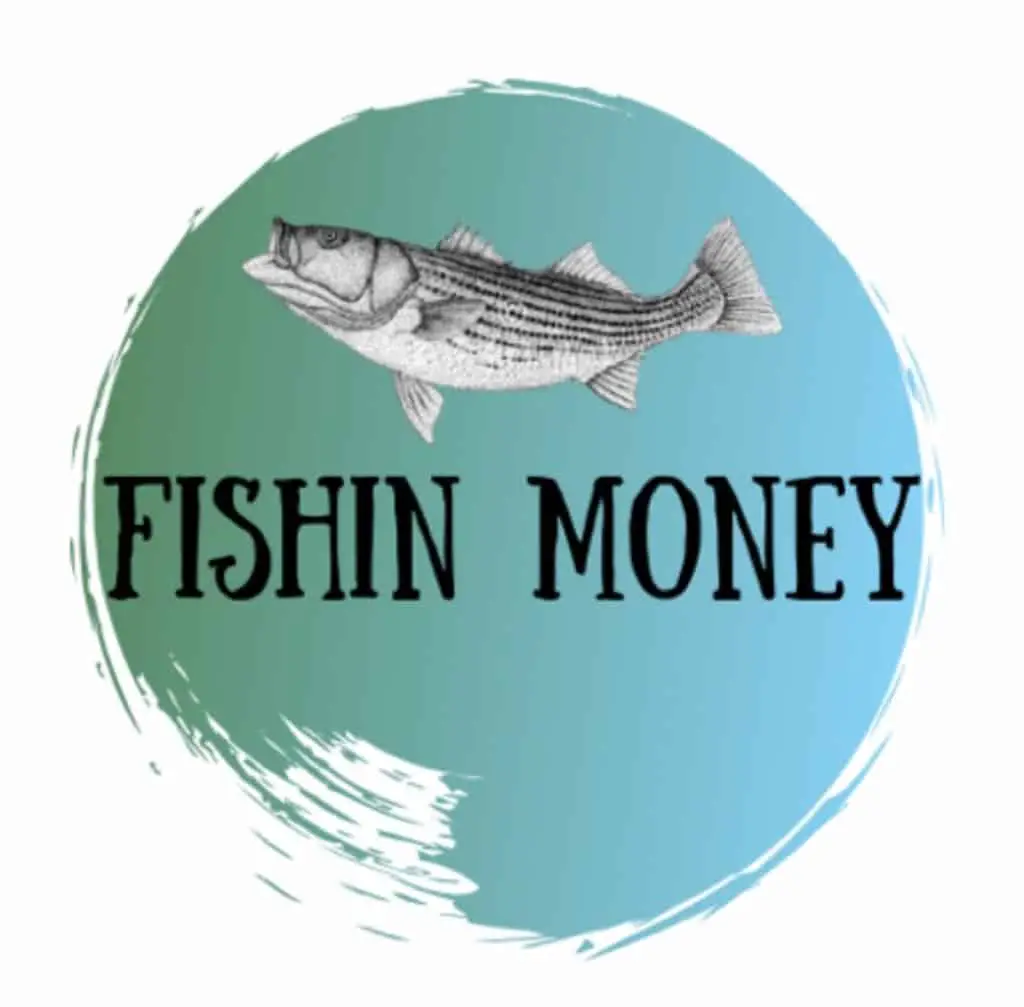
Whether you are a beginner, intermediate, or advanced in catching striped bass there is always something new to learn. So what are the best striped bass lures?
Depending on the area that you are fishing in factors such as weather, rod/reel, boat or no boat, live bait, or lures can determine whether or not you catch the big striped bass that you are longing to add to your list of trophy fish. As an opportunistic fish, the striped bass can be caught with just about any bait.

If you choose to use a lure, there is an abundance out there that will work. If you are fishing in a new area make sure to visit the local bait and tackle shops. They are usually willing to give you advice and share what lures work best for their area.
Top-25-Best-Striped-Bass-Fishing-Lures-–-Fishin-MoneyDownload
I am going to help you out here, by covering the all-time best fishing lures used for many many years to catch striped bass. Some of the lures date clear back to the 1930s and ’40s.
To start off, I’m going to cover the categories of the best striped bass lures and then we will move into the top 25 that professional anglers swear by.
Whether you are fishing in saltwater or freshwater, most of the lures will work for either area. Striped bass can grow to weigh 50+ pounds in freshwater and up to 120+ pounds in saltwater.
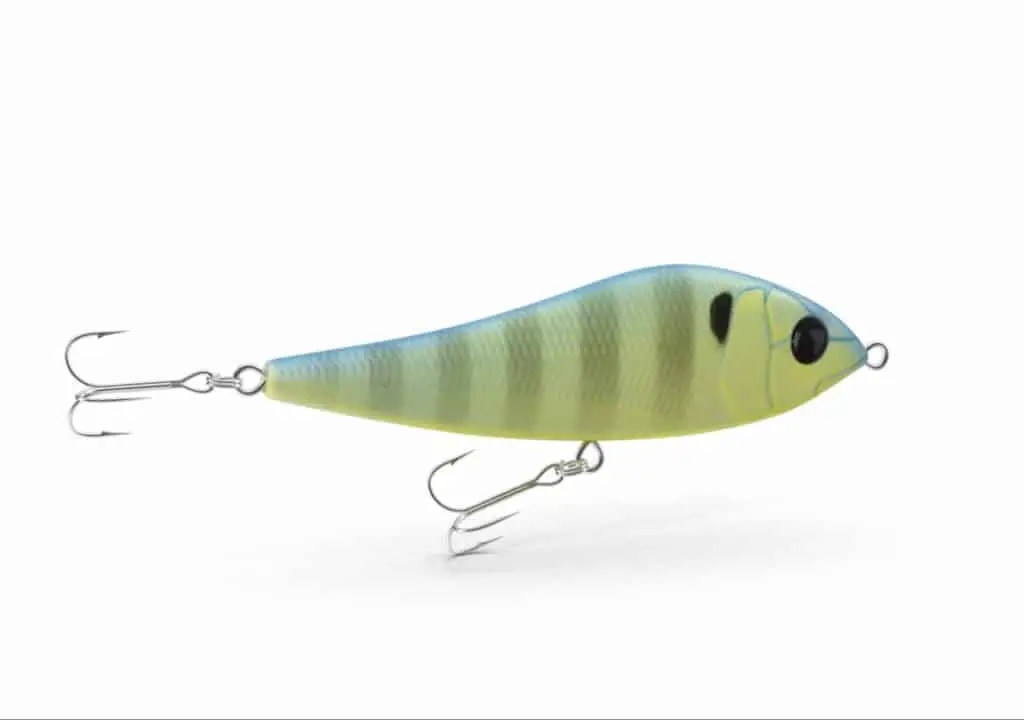
Topwater Fishing Lures
These can be used anywhere that you see striped bass on the surface. Use the bigger, noisier lures in low-light; after dark, at dawn or dusk, when the water is choppy, or on rainy days.
The more realistic, quieter lures work better as the sunlight intensifies. During mid-day, you will want to break out your most life-like and subtle lures if you want to catch a striper
Heres a good one to try on salt water or fresh water. Lots of action River2Sea Whopper Plopper.
Prop Baits:
Best bright and early in the morning, they attract that striped bass that isn’t quite awake yet. Also a good bait for rainy and overcast days. They are very easy to use; cast and retrieve at a steady pace.
A good tip for using prop baits to catch striper; they are often hit many times without “hooking up”. Twitch the lure gently, the prop will barely sputter and the striped bass will come back and bite. But beware, striped bass are vivacious fish, they don’t just bite the hook they attack the hook yanking extremely hard, so hold on tight! This one will really chop up the water attracting those cows. It looks like a shad too.
Poppers:
These are extremely effective in low light and work like magic on schools of striped bass. Poppers are also effective in choppy water because they are noisy, imitating an injured baitfish.
They range in size from just a couple of inches to a whopping 7-inch lure for the saltwater monsters, as stripers are called in certain areas. If you want to get the job done in a HEAVY DUTY way try these wire through Poppers.
Surface Minnows:
One of the most popular of the variety of landlocked lures to catch the striped bass.
The best time is either early or late in the day, but will also work in the bright sunlight. Keep the top of your rod high in the air and use a slower retrieve. A good tip for using surface minnows; bone-white is deadly to the striped bass, so remove the hooks and buff off the paint on the body of the lure. Replace the back hook with one size bigger and put the two front hooks back in place. Striped bass can not resist the bone-white color. One of the most recommended is this one.
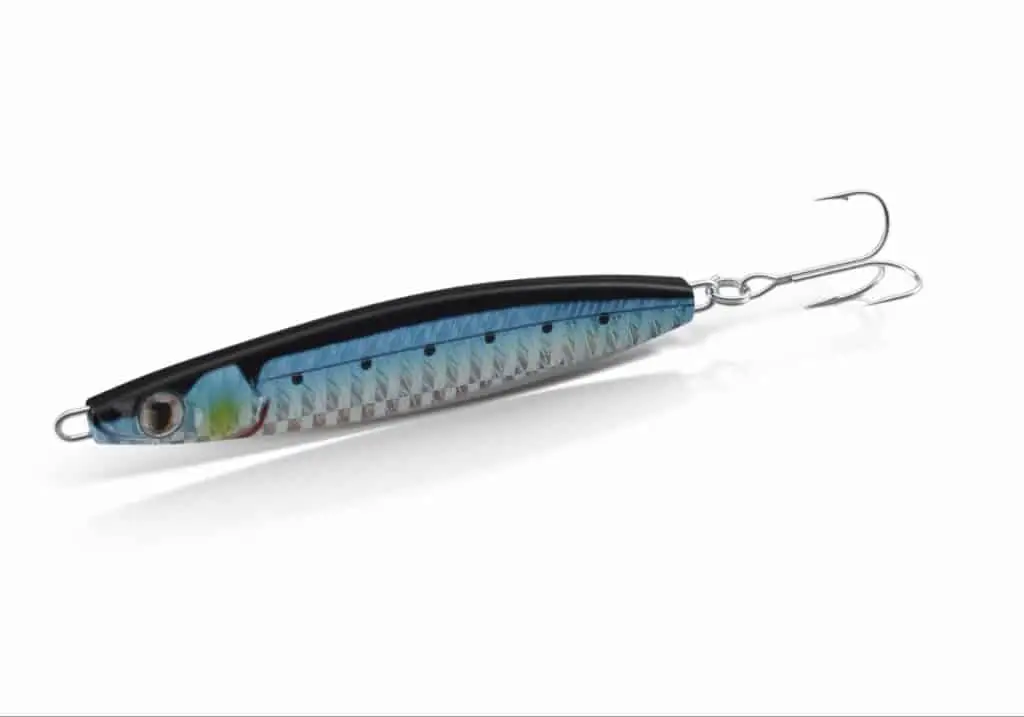
These are best used on tailwaters or reservoirs as the morning fog is dissipating. It is recommended to use a shorter pole, 6 feet in length, and to keep the tip of the pole pointed to the surface of the water.
Stick Bait:
Tip: use bass sized stick bait on bright days. Remove the screws holding the hook hangers and dip them into an epoxy cement and immediately put them back in. This will keep that big striped bass from pulling the hooks out of your lure. Try the Dr.Fish Big Minnow Stick Bait.
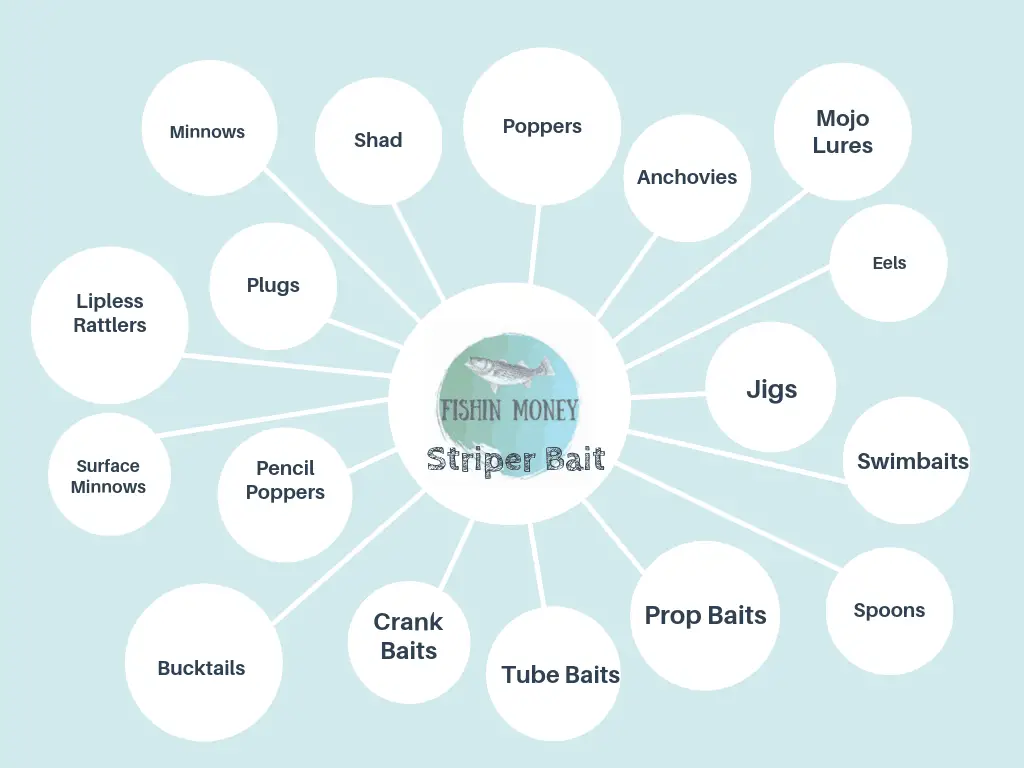
Soft Plastic Fishing Lures
Produced in a large array of colors, sizes, and shapes. This is the most versatile category of bait to catch the striped bass. They can be used anytime, anywhere, and in any condition.
Some of the soft plastic lures mimic lizards, shad, worms, craw, minnows, and grubs just to name a few. To make the lure more attractive to the striped bass, choose lures that have a special “scent” that will pique the stripers’ interest. You can also spray the scent, or soak your lure in a scent that the fish will love. Berkely Gulp offers exceptionally scented lures. For example the Berkley Gulp Eel. There are many other varieties as well.
Soft Jerkbaits:
Amazingly realistic, these types of lures will catch stripers from daybreak until dark. Extremely useful in shallow water, where other bait may be ignored by the striped bass. Most anglers use this bait slowly, but for clear water, stripers try retrieving faster than normal.
This makes the bait skip, jump, and jerk just under the surface of the water. Go shallow in the springtime with the soft jerk bait. They shine around flats or in shallow cover when the striped bass is cruising. Do not pack up the soft jerk baits when the temperatures drop. They still work, you just have to go deeper and retrieve slower. Here’s a fine example.
Leadhead Trailers:
You can use these on a regular lead-head or on bucktails. Early in the spring, in shallow water try using the bucktail in coves or reservoir points. Shadtail or eel trailers can easily be substituted for twisters. Striped bass often uses submerged trees to hide and ambush their prey in rivers.
Lead-head is a soft lure with hook sinking swimbaits for salt or freshwater. You can dress them with grub, feathers, hair, or pork rinds to add to the appeal of the lure, making the striped bass want to attack.
Tube Baits:
Another bait that is very life-like and dangerous to the striped bass. These are best used when the bite is slow. Try using a big tube with a heavy sinker, down to 35 feet around ledges and reservoir points.
You can also bump them across the bottom by using a salt-water lead-head. If you fill a big tube with the styrofoam packing peanuts, and place on a stout hook, it will float. Enticing the striped bass that is just under the surface of the water.
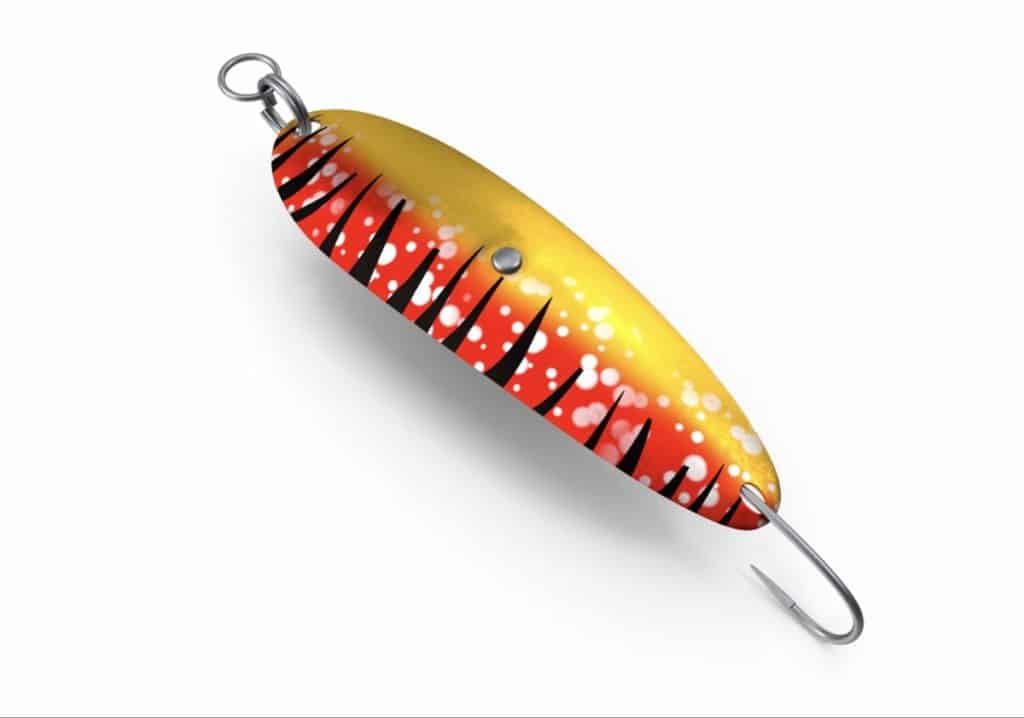
Spoons & Blade Lures
These are able to be fished in a variety of ways and are made of bright flashy metal. You can use them straight through a school of striped bass, jigging them up and down. They are also great trolling lures or under the lights during night fishing.
Jigging Spoons:
With these lures, you want to go for the bigger fish if the schools of striped bass are on the surface of the water. Reel in quickly while holding your rod high.
Depending on wind conditions, depth, and current it is recommended to use 3/4 to 3 oz spoon. These particular ones are best used around 15-foot deep water and are best using a boat with a fish finder to get the perfect depth and locate the perfect striped bass.
Trolling Spoons:
Avoid trolling with a constant speed when using this type of lure on striped bass. The striper will respond better when you change the pace of the lure. The trolling spoon is intended for downrigger use only. These lures can hook a big striped bass as well as a trout or a walleye.
Blade Baits:
With this type of bait, it is cast like a bullet, so if the wind picks up switch to one of your blades to get the extra distance on the cast. 1/2 -3/4 ounce tail-spinner is going to work best in fall and early winter.
The blade baits are more effective than a stick bait because it can go down as deep as 30-40 feet. Allow your bait to sink, after a long cast and reel in at a steady pace all the way back to the boat (or shore).
Crankbaits
Crankbaits use in fall and spring when the striped bass are shallow but not quite on the surface. The lures bill is what determines whether it is deep water, medium, or shallow water plug. Coming in a wide variety of widths, shapes, and colors they allow you to explore various depths of water.
Lipless Rattlers:
These are preferred on a high-speed reel, but it is a bad idea for a striper. The best reel is a wide-spoon with a standard retrieve. As it moves through the water it sends out a vibration because of the built-in rattle.
Cast and reel right down the middle of a school of baitfish and make sure to reel them quickly, staying just below the surface. Where there is a school of baitfish, there are going to be striped bass. Some of the color choices that you have with this lure; bone-white, black back chrome, and blue-back chrome.
Medium Divers:
Striped bass often feeds on flats and shallow bars at night and will hit this without hesitation. These baitfish imitating divers are slender and long lures.
Choose ones that can get you up to 15 feet down. Your best bet with this type of lure is to fish around standing timber, probing points, and humps. The primary colors are; bone, rainbow trout, and shad.
Deep Divers:
Just as their name suggests, these lures can go between 20 and 30 feet deep if trolling on a long line, which is ideal. Look for open water, humps, and of course deep points to troll. White, fire tiger, shad, and rainbow trout are your go-to colors. One of the most popular and best examples of a deep diver is Mann’s Stretch Series.
They are durable and strong, withstanding the fighting from the large saltwater game fish. You can get them in a large range of sizes; the Stretch 15 goes down to fifteen feet, the Stretch 25 will go down to 25 feet, etc…
Diving plugs work great in salt and freshwater. Professional anglers advise you to try and match your lure color to the color of what the fish are dining on at that particular time. It will make it more irresistible to the striped bass. If the colors contrast too much, they will move away from your lure and go elsewhere to feed.
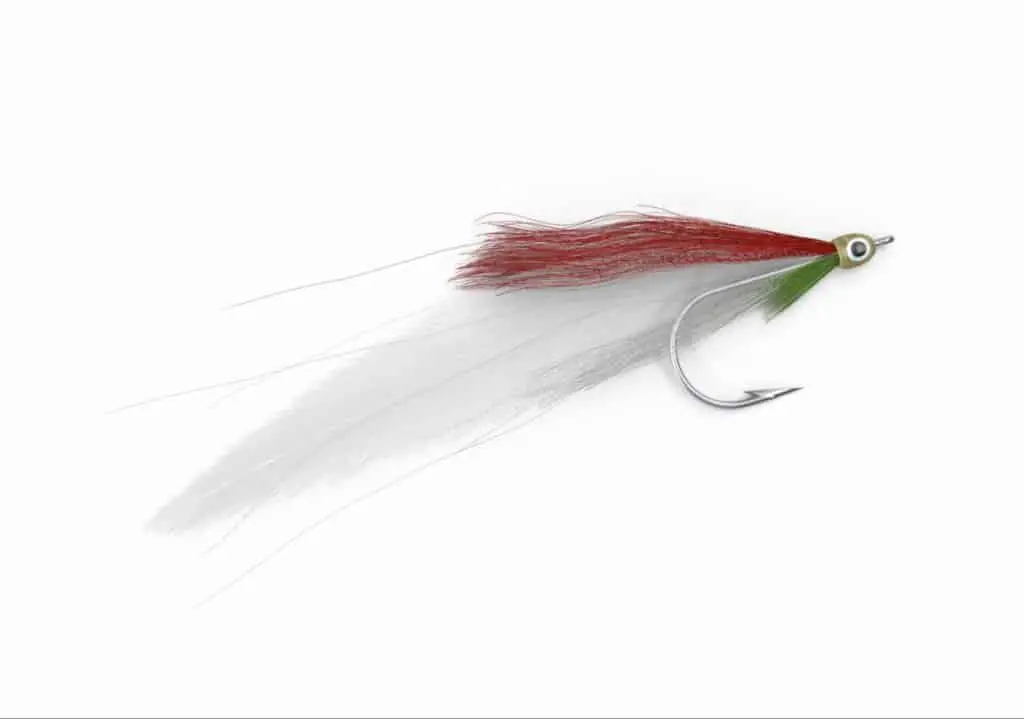
A very simple lure with a weighted head and a single hook. Lined with feathers, they work well in both fresh and saltwater.
Bucktails
They come in a wide variety of sizes and colors that are sure to attract that big striped bass. By varying your retrieval speed you can control the depth of the bucktail. To make the bucktails look more like a striped bass meal, try adding a grub tail to your hook. This will add a little extra action to your hook during retrieval.
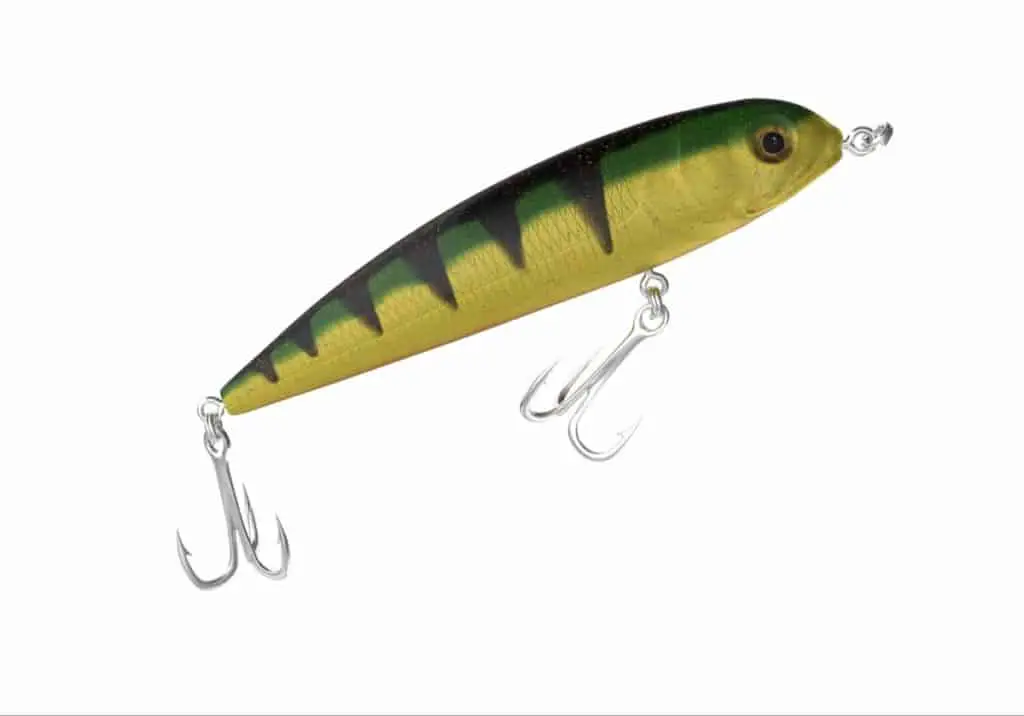
Striped bass are considered marine fish. They migrate from the ocean to the coastal rivers each spring to spawn. So, these elusive fish can be found in fresh, brackish, or saltwater.
Constantly on the move and somewhat unpredictable, the striped bass can be tricky to catch. Because of this, there are many proven lures and techniques that work to snag that feisty striper. But, depending on daily factors; such as weather, the area being fished, live bait used, trolling, or shore fishing some of the techniques may not work.
Some of the best lures are the ones that resemble the forage in the area and they can be made out of metal, plastic, resins, wood, or rubber. We have covered the categories of lures that can be used to catch striped bass.
The top 25 lures of all time
In part 2 we are going to explore what some anglers swear by, as the top 25 lures of all time. This list has been researched from many different places all over the internet. Just remember, you can ask 10 different professional anglers the best lure to catch striped bass and guaranteed they are all going to have a different answer and it, as stated above, will have a lot to do with many different factors for the area.

This is part 2 of our ‘top lures for striped bass fishing’‘. In the 1st section, we covered all of the different categories of lures; poppers, crankbait, stick bait, topwater, prop baits and many more. In part 2, we are going to go in-depth and cover the top 25 striped bass lures of all time.

These were found by researching many different sites all over the internet. Some of this dates back to being first produced in the 1930s and ’40s. So let’s get strapped in and explore!
Creek Chub Pikie:
Designed in 1920, intended on catching pike, surf casters soon realized that bigger versions attracted the striped bass. Creek Chub produced a striper pikie. it was a heavier duty replica of the original, able to withstand the strength and pull of stripers.
Bomber Long A:
Before being used in saltwater, this lure was produced in 1970 for walleye. Anglers love this lure for striped bass because of its affordability. You want to reel quick enough for the diving lip to dig but don’t reel too fast.
November 5, 2012, the Bomber Long A landed a gentleman a 58-pound striped bass in Rhode Island.
Boone Needlefish:
This is an affordable jig that gives great results in snagging a variety of “bottom fish”. Available in 8 sizes its colorful finishes attract the bone-jarring strikes of the striped bass. You can also choose a classic wood Needlefish by Boone that allows slow sinking action. These lures closely resemble a slender baitfish, such as a sand eel, which is popular with striper anglers. Boone Needlefish
Gibbs Pencil Popper:
Has a tapered design that simulates many forage fish. They come in a variety of sizes from 1/2 oz to 3 1/2 oz. The most successful retrieve with this lure is to point the tip of the rod down, towards the lure, and create a steady up and down action.
Many of these plugs have been tested on the waters of the Cape Cod Canal, before being sold. The pencil popper attracts big striped bass when you use it to fish around schools of mackerel, bunker, and mullet.
Cotton Cordell Red Fin:
Anglers vote this as one of the best wake baits ever created. You will receive unpredictable, vicious bites from striped bass if you retrieve it slowly. To get the best casting out of this light-weight lure, add about 10cc’s of water to the hollow body. In 1984 a huge 61-pound striper was caught with the redfin lure. Although it swims closer to the surface, this lure mimics other minnow type lures.
Super Strike Super ‘N’ Fish:
One of the most lifelike sinking lures in the water. This series of lure is a must-have in your striped bass arsenal, as it is virtually indestructible. Tapered at both ends, they were designed to match closely to sand eels.
On a 6 3/8 inch Super ‘N’ Fish lure, a 64-pound striped bass was snagged in the Long Island surf. They have been very successful in striped bass fishing both on the East and West coast.
Yo-Zuri Mag Darter:
Yo-Zuri Mag Darter:
This series boasts a “magnetic weight transfer system” enabling anglers to cast farther and cover more water than other lures. These are more productive if you retrieve them slowly. Customer reviews show great quality, superb action, and excellent at catching striped bass. Available in a wide variety of colors, mainly holographic. The depth is 3-feet and they weigh 1 ounce and boast 3D eyes to attract the predatory striped bass. This series is favored by anglers in Cape Cod, New Jersey, and Montauk.
Andrus Jetty Caster:
These are bucktails that are optimal for fishing over rocks or in the surf. The extra hair allows for longer float time and increased action. The jigs range in size from 3/4 oz to 3 oz and come in a variety of colors. Widely popular and heavily used at the Montauk Lighthouse in October.
Specifically made to catch the striped bass, which is prominent in Montauk. If you add a pork rind strip to this lure, as a trailer, be prepared for a vicious striper hit on your line.
Atom 40:
Spectacular saltwater surface plugs. Early on, they were mimicked after the Creek Chub Pikie, only heavier and better suited for saltwater. First sold out of the trunk of a car on the Cape Cod Canal. The original Striper Atom was available in 3 colors; whiting gold, herring blue, and blue & silver. Due to the heavy through-wire that ran the length of the lure, these could withstand the bold unpredictable strikes by the striped bass.
Super Strike Zig Zag:
A very large variety of colors, these lures are one of the favorites of the fishermen in Montauk. Swimming 2-3 feet deep, digging into rips with fierce darting patterns especially successful during a strong current. The weight on these is 2 3/8 oz and 6 5/8 inches long. These lures also work great in calmer conditions. Anglers suggest using this plug after dark, slowly reeling in against a moving tide.
Reverse Atom:
A simple, backward, Atom 40. It was stumbled across by a surf caster who removed the hooks from the Atom 40 and tied it on backward. Striped bass went nuts for this lure. He went to the creator and asked him to produce lures in the backward style and so the Reverse Atom was born! Amber-colored, it was made to look like a squid.
The Reverse Atom is also known as the Whistling Plug because of the 2 holes that are drilled in it. They make a unique whistling sound when cast.
Danny Plug:
Used to catch striped bass in big surf and calm backwaters. Also successful close to the shore and after dark. The plugs are made to swim on the surface. A lot of Danny Plugs roll side to side while you reel in. For that reason, anglers prefer the plugs to not have eyes, because of concerns that the striped bass will be tipped off to the fact that the lure if fake.
Acme Kastmaster:
This series of lure will not corrode, bend, or break; and is precision machined. Excellent in fresh or saltwater, the aerodynamics make it the “master distance catcher”. The 1/2 oz to 1 oz sizes is ideal for catching striped bass. There are 47 colors available and the price is very easy on the wallet. If you are battling windy conditions, these are the perfect lures; made to cast like a rocket. The shape of the Kastmasters resembles herring, juvenile bunkers, and other forage bait; attracting all sizes of striped bass.
Gibbs Casting Swimmer:
A little bit on the more expensive side, there are 3 sizes available; 1, 2, and 3 ounces. All of them are also referred to as the “bottle plug”. Without the metal lip, these lures can maintain their aerodynamics, allowing these lures to reach the ‘off beach’ rips. All sizes are available in 6 colors and were made specifically for the most turbulent water and longer casts.
Daiwa Salt Pro Minnows:
Available in 20 colors and 6 sizes for depth variation, you can’t go wrong with this series of the lure. With a realistic scale pattern and its 3D eyes, they are very life-like.
These lures produce a longer cast and boast heavy saltwater hooks making the catching of a striper a blast and a challenge. The Salt Pro Minnows are popular in the Cape Cod Canal, Rhode Island, and Long Island with catches up to 40+ pounds.
Northbar BottleDarter:
This lure is extremely versatile and can be used in many different ways. Available in 21 enticing colors to attract striped bass. If you are fishing on open beach water it is recommended to use a slow and steady retrieve. These lures can swim across the surface on nice calm nights. While this lure was being tested in 2009, before being put on shelves, it snagged a 60-pound striped bass.
Super Strike Littleneck Popper:
These have been designed to replicate realistic movement, perfectly weighted to help with casting. These poppers sink slowly which allows you to retrieve at a slow pace. Available in 17 colors and 3 sizes, these lures boast heavy split rings and hooks, giving them the ability to withstand the tough bite and yank of striped bass.
RM Smith Swimmer:
With an extra-wide wobble and metal lip these lures blend in with squid, bunker, herring, and mackerel; the 2oz size is the most popular. Depending on your rod height and your retrieval speed you can swim these on the surface or you can retrieve quicker and it will dive down, mixing in with the other swimming baitfish. Available in many color combinations, this series is a little more costly than others.
Lunker City Slug-Go:
Ranging from 3 inches to a whopping 12 inches in length, this was one of the first super-soft stick baits on the market. This series draws very instinctive strikes from all predatory fish including the striped bass. It imitates an injured prey action and is erratic on the retrieval. Available in 12 colors and 3 inches, 4.5 inches, and 6-inch length depending on the color you choose. These are the perfect lures for beginners because they do not get snagged on anything and you can cast and reel at a steady pace, while still catching a decent sized striped bass.
Sebile Stick Shadd:
Sebile Stick Shadd:
Covering almost all fishing situations, it was designed to be controlled, 100%, by the angler. With this particular lure, there is no “wrong way” to fish. Ranging from 2 3/8 inches to 8 1/4 inches and 1/8 oz up to 7 3/8 oz.
Unique to this lure, when you order them you get 5 different buoyancy choices as well. The Stick Shadd lures are stable in all water conditions, great for long-distance casts, and erratic swim action.
Atom Striper Swiper:
Produced in 1956, the tail is weighted to improve your casting distance. Even in rough or windy conditions, this holds a steady position in the water. Available in 5 sizes and 4 colors, these lures are deadly on all species of fish, including the striped bass. Made of a cylindrical hard plastic, with no eyes, this lure has a cupped slanted face that enables it to float to the surface, even with a very slow retrieve.
Red Gill Rascal:
This lure is a must-have on the sandy beaches from Jersey to Cape Cod, where the sand eels thrive. The Red Gill is best used as a rig teaser in front of your plug, and they will attract a 30+ pound striped bass. Make sure you rig them with a very strong, heavy-duty hook to ensure you don’t lose the HUGE striped bass that hooks your bait. 2 sizes are available; the 4 1/2 inch and the 7-inch. YES! The 4 1/2 inch lure can snag a striped bass that is 50+ pounds.
Tsunami Swim Shad:
These lures have a soft body that mimics a baitfish and offers a 3D life-like meal to the striped bass. Boasting a tumble free casting and weight balancing design. Swim Shad are available in 4″ to 9″ length and 6 different colors with a Mustad Ultra-Point hook.
Tsunami Swim Shad were made so anglers could control the sink rating, positioning it perfectly for those striper strikes at feeding time. You can also do a simple lift and drop retrieval, which will attract striped bass.
Point Jude Tins:
offering a bright nickel finish, heavy-duty hardware, and hand-tied bucktail hooks that are saltwater tough. You can sue these successfully off the rocky coast of Rhode Island, the beaches of Cape Cod, and the jetties of New Jersey. Point Jude Tins were produced in 1946 and made to mimic sand eels, peanut bunker, mackerel, and butterfish.
Yo-Zuri Surface Cruiser:
Yo-Zuri Surface Cruiser:
Perfectly weighted for long-distance casting, you can use a skipping action or “walk the dog” style retrieval to entice a striped bass. Available in 11 colors and 4 sizes these lures may make your wallet wince just a little bit, as they are one of the more expensive lures out there. Unfortunately, these did not hold popularity for very long and have been discontinued. So if you should happen to come across one of these at a yard sale or thrift store; GRAB IT!
Now that your brain is on overload from all of the information that we have provided you on the best lures to use when you are chasing striped bass, it is time to pick which one/ones you think are going to work best for you. Remember to take the normal factors into consideration; your area, weather, river/ocean, dawn, dusk, night fishing, trolling or beach/sand fishing. Grab the wallet and the gear and let us get to the water!!
Grab All my Fishing tips in my valuable monthly newsletter!
[wpforms id=”408″ title=”false” description=”false”]
Hey FISHMONGER – make sure to check out my FISHING RESOURCES page.

